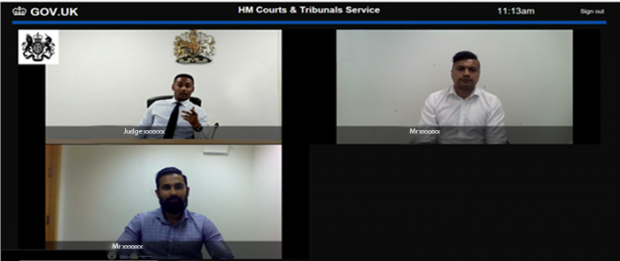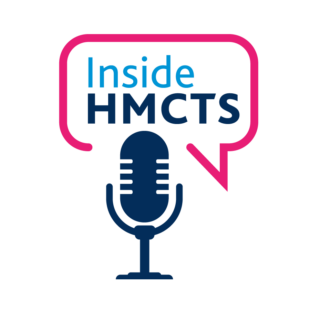[English] - [Cymraeg]
Today we are publishing the results of the independent process evaluation into the video hearing pilot. It has been testing user experiences - of the appellant, judges and officials in HMRC – of those participating in a real hearing in a tax tribunal. Running since March, the tax pilot has tested the technology and processes that will allow hearings to use video, where it is deemed appropriate by the judiciary. Throughout the pilot we invited an independent evaluator from the London School of Economics to attend the hearings and record their findings. Their final report can be found on GOV.UK.
What the evaluation tells us
Of the cases considered for a video hearing, eight hearings were held, so this was a small pilot. The testing was specifically focussed on people’s experience of being part of the hearing rather than anything else. The results of the pilot were largely what we expected at this stage and showed that overall, users reported high levels of satisfaction with video hearings, particularly due to the practical advantage of not having to travel to a physical court. Participants reported that the hearing itself was clear, easy to navigate, user-friendly and formal enough not to diminish the majesty of the court. However, all hearings experienced delays and minor technology fails (such as wifi dropping out), although most problems were resolved quickly and users still felt they could participate effectively.
So, we can take from this that when it works well and it’s suitable, video hearings have the potential to be a more convenient option for some people. We acknowledge that the technology is hard to get right and we need to do a lot more to make it robust, as well as continuing to help users test whether their own equipment at home is compatible, with a strong enough internet connection for example. This is something we’re already working on.
We need to continue to make sure the right people and hearings are identified as appropriate for use of video. This is something which we did successfully in the pilot but it needs to remain a top priority.

The fundamental principle of open justice means that we will continue to explore ways that hearings can be accessed by the public, but in the meantime all pilots will require the judge to remain in a traditional court room allowing observers to witness proceedings as they do now.
My visit to see a video hearing live
In June I visited the tax tribunal to view a video hearing pilot in person, where all parties joined online from separate locations across the country, using their own equipment. I watched as people based in Manchester, Northern Ireland and the judge sitting in a court room, came together and could be seen and heard clearly - not only to each other, but to journalists and members of the public who might have wanted to observe the hearing as they are entitled to.
The hearing had to be adjourned and rescheduled to another date as the judge ruled that an additional participant was required to attend. Conducting this hearing by video meant that considerable time and cost was saved as the parties didn’t attend the court building only for it to be adjourned to another date shortly after it began. I watched as the judge talked directly to the parties on the video and explained what was to happen next.
Understandably, it wasn’t all perfect. There were some glitches, which we’ll learn from. That is exactly why we conduct such pilots, in a live environment.
I was pleased to hear directly from the project team about how the pilots had worked well for other users. For example, I was told about an appellant from Greece who could participate in their hearing without having to travel to London.
Another appellant had recently become a parent and was very pleased to present their case via video and not have to leave their child for longer than necessary.
What next?
We have already started acting upon most of the report’s recommendations and will carry out further testing and piloting later this year as the technology continues to develop.
The prospect of video hearings gives rise to concerns for some – mainly about making sure they are used in the right way and for the right things, and that’s why we are piloting their use and evaluating the impact carefully. We also acknowledge that they are not suitable for every hearing and expect their use to be initially relatively limited as Kevin Sadler recently blogged. We know this is important and we want to get it right – we’re being open about our findings as we progress.
Thank you
These pilots could not take place without the support of many people to try something new. In particular I am grateful to the judiciary not just for taking part but for the careful consideration about cases that were suitable and appropriate for this sort of hearing. Exercise of this discretion will always be at the centre of the use of video.
Thanks also to those from representative groups who helped us – including Judicial Engagement Group, Magistrates Engagement Group, Equalities Group, Litigants in Person Group and those who gave us their views at the HMCTS legal roadshows.
I am also very grateful to the appellants who took part in the pilots, who were patient with glitches and who gave us their honest (and mostly positive) feedback.
[English] - [Cymraeg]
Gwrandawiadau Fideo Ar Brawf
Heddiw rydym yn cyhoeddi canlyniadau gwerthusiad annibynnol o’r cynllun peilot gwrandawiadau fideo. Bu’r cynllun yn archwilio profiad defnyddwyr – yr apelydd, y barnwyr a swyddogion HMRC – a oedd yn cymryd rhan mewn gwrandawiad go iawn mewn tribiwnlys treth. Mae’r cynllun peilot treth, sy’n rhedeg ers mis Mawrth, wedi profi’r dechnoleg a’r prosesau a fydd yn caniatáu i wrandawiadau ddefnyddio fideo, lle y mae’r farnwriaeth yn credu bod hynny’n briodol. Trwy gydol y cynllun peilot gwahoddwyd gwerthuswr annibynnol o’r London School of Economics i fynychu’r gwrandawiadau a chofnodi ei ganfyddiadau. Gellir gweld ei adroddiad terfynol ar GOV.UK.
Beth mae’r gwerthusiad yn ei ddweud
O blith yr achosion a ystyriwyd ar gyfer gwrandawiad fideo, wyth gwrandawiad a gynhaliwyd, felly cynllun peilot bychan oedd hwn. Canolbwyntiwyd yn benodol ar brofiad pobl o fod yn rhan o’r gwrandawiad. At ei gilydd roedd canlyniadau’r cynllun peilot yn gyson â’r hyn yr oeddwn yn ei ddisgwyl ar hyn o bryd ac roeddent yn dangos bod defnyddwyr, at ei gilydd, yn nodi lefelau uchel o fodlonrwydd gyda gwrandawiadau fideo, yn neilltuol oherwydd y fantais ymarferol o beidio gorfod teithio i’r llys. Adroddodd y rhai a gymerodd ran yn y cynllun peilot fod y gwrandawiad ei hun yn eglur, yn hawdd ei ddilyn, yn hwylus ac yn ddigon ffurfiol fel nad oedd urddas y llys yn ddim llai. Fodd bynnag, bu oedi gyda’r holl wrandawiadau a bu mân anawsterau technolegol ym mhob achos (y wifi ddim yn gweithio ar dro, er enghraifft), er bod y rhan fwyaf o’r problemau hyn wedi eu datrys yn fuan a bod y defnyddwyr yn dal i deimlo eu bod yn gallu cyfrannu’n effeithiol.
Felly, gellir casglu ar sail hyn fod gan wrandawiadau fideo, pan fyddant yn gweithio a phan fernir eu bod yn addas, botensial i fod yn ddewis mwy cyfleus ar gyfer rhai pobl. Rydym yn cydnabod ei bod hi’n anodd sicrhau bod y dechnoleg yn gweithio bob tro a bod angen gwneud mwy i sicrhau ei bod yn atebol, ynghyd â pharhau i gynorthwyo defnyddwyr i brofi a yw eu cyfarpar gartref yn gydnaws â’r dechnoleg, gyda chyswllt gwe cryf er enghraifft. Rydym eisoes yn gweithio ar y materion hyn.
Mae angen inni barhau i sicrhau bod y bobl iawn a’r gwrandawiadau iawn yn cael eu hadnabod fel rhai addas ar gyfer gwrandawiad fideo. Gwnaethpwyd hynny’n llwyddiannus yn y cynllun peilot ond rhaid i hyn barhau i fod yn flaenoriaeth.
Mae egwyddor sylfaenol cyfiawnder agored yn golygu y byddwn yn parhau i chwilio am ffyrdd newydd i’r cyhoedd gael mynediad at wrandawiadau, ond yn y cyfamser, ym mhob cynllun peilot, bydd yn rhaid i’r barnwr aros yn yr ystafell lys draddodiadol gan ganiatáu felly i’r cyhoedd wylio’r gweithrediadau yn y modd arferol.
Fy ymweliad â gwrandawiad fideo byw
Ym mis Mehefin ymwelais â thribiwnlys treth i weld cynllun peilot gwrandawiad fideo, lle'r oedd y partïon yn ymuno ar-lein o wahanol leoliadau ar draws y wlad, gan ddefnyddio eu cyfarpar eu hunain. Gwyliais wrth i bobl ym Manceinion a Gogledd Iwerddon a’r barnwr, a oedd yn eistedd yn yr ystafell lys, ddod ynghyd a gellid eu gweld a’u clywed yn glir. Roeddent nid yn unig yn clywed ac yn gweld ei gilydd, ond gallai newyddiadurwyr ac aelodau o’r cyhoedd y gallai fod arnynt eisiau gwrando ar yr achos eu gweld a’u clywed hefyd.
Bu’n rhaid gohirio’r achos a threfnu dyddiad arall gan i’r barnwr ddyfarnu bod angen i gyfrannwr arall ymbresenoli. Roedd cynnal y gwrandawiad drwy fideo yn golygu arbed cryn amser a chost gan na fynychodd y partïon adeilad y llys cyn gohirio’r achos yn fuan ar ôl iddo ddechrau. Gwyliais wrth i’r barnwr siarad yn uniongyrchol gyda’r partïon dros y cyswllt fideo gan egluro beth fyddai’n digwydd nesaf.
Wrth gwrs, nid oedd drefn yn berffaith. Profwyd rhai mân anawsterau a bydd y rheiny’n fodd inni ddysgu gwersi at y tro nesaf. Dyna pam ein bod yn cynnal cynlluniau peilot o’r fath, mewn amgylchiadau ‘byw’.
Roeddwn yn falch o glywed yn uniongyrchol gan y tîm prosiect am sut yr oedd y cynllun peilot wedi gweithio’n dda i ddefnyddwyr eraill. Er enghraifft, clywais am apelydd o Wlad Groeg a allodd gymryd rhan yn ei wrandawiad heb orfod teithio i Lundain.
Roedd apelydd arall wedi dod yn rhiant yn ddiweddar ac roedd yn falch o gyflwyno ei achos drwy gyswllt fideo heb orfod gadael y plentyn am fwy o amser nag oedd rhaid.
Beth nesaf?
Rydym eisoes wedi dechrau gweithredu ar y rhan fwyaf o argymhellion yr adroddiad a byddwn yn sefydlu cynlluniau peilot pellach yn nes ymlaen yn y flwyddyn wrth i’r dechnoleg barhau i ddatblygu.
Mae’r syniad o wrandawiadau fideo yn achos pryder i rai – pryder yn bennaf ynghylch sicrhau eu bod yn cael eu defnyddio’n iawn ac ar gyfer y pethau iawn, a dyna pam yr ydym yn cynnal cynlluniau peilot ac yn gwerthuso eu heffaith yn ofalus. Rydym hefyd yn cydnabod nad ydynt yn addas ar gyfer pob achos ac yn disgwyl i’r defnydd ohonynt fod yn gymharol gyfyng ar y dechrau (gweler blog diweddar Kevin Sadler). Rydym yn gwybod bod y gwaith hwn yn bwysig ac rydym am sicrhau ei fod yn cael ei wneud yn iawn – gan fod yn agored am ein canfyddiadau wrth i’r gwaith fynd rhagddo.
Diolch
Ni fyddai modd cynnal y cynlluniau peilot hyn heb gefnogaeth llawer o bobl sy’n awyddus i wneud rhywbeth newydd. Yn neilltuol, rwy’n ddiolchgar i’r farnwriaeth am gymryd rhan ac am roi ystyriaeth fanwl wrth benderfynu pa achosion fyddai’n addas ar gyfer y math hwn o wrandawiad. Bydd defnyddio disgresiwn yn ganolog i’r defnydd o wrandawiadau fideo.
Diolch hefyd i’r aelodau o grwpiau cynrychioliadol a fu o gymorth inni – yn cynnwys y Grŵp Ymgysylltu Barnwrol, Grŵp Ymgysylltu’r Ynadon, y Grŵp Cydraddoldeb, Grŵp Ymgyfreithwyr Drostynt eu Hunain a’r rheiny a roes eu barn yn ystod sioe deithio gyfreithiol GLlTEM.
Rwy’n ddiolchgar hefyd i’r apelwyr a gymerodd ran yn y cynlluniau peilot, a fu mor amyneddgar ac a roes adborth gonest (a chadarnhaol at ei gilydd) inni.
